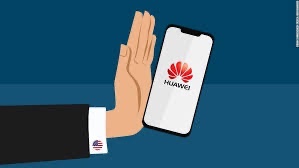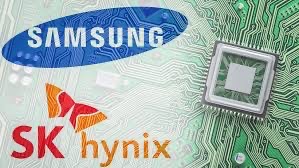

Chinese Semiconductors: Must Solve on Their Own!
– U.S. to ban all export licenses to Huawei –
-Please make a semiconductor with 0% American technology-
US Sanctions on China:
The United States is increasingly likely to impose broad restrictions on China in the semiconductor sector.
Specifically, it calls for a “total ban on export licenses for Huawei products.”
wall street journal
(as of March 1)
-Not yet officially decided, but under consideration-
Reason for total ban:
Semiconductors exported from the United States are being diverted to Russia.
Restrictions on two Korean companies:
the United States
He is giving a red flag to “two Korean companies producing semiconductors in China.”
It is also seen as “promoting two Korean companies to withdraw from China in the future.”
Sanctions against Huawei:
Here, I would like to look at how Huawei was driven out of the United States on a time axis.
1) Do not buy advanced semiconductors from the United States (May 2019)
2) Do not allow foreign companies to produce semiconductors designed by Huawei (May 2020)
3) Do not buy semiconductor products from countries other than the United States. Because US technology is used (August 2020)
4) Make and use semiconductors with 0% US technology.
This is the final position of the United States.
Huawei’s interaction with the United States:
Huawei asked, “Where can you find semiconductors that do not contain US technology? Are you telling us not to use semiconductors in China?”
The U.S. did not take it seriously, and pushed it away, saying, “Make and use semiconductors with 0% U.S. technology.”
Restrictions for Chinese companies:
In October last year, the United States restricted the provision of manufacturing equipment, parts, and technology to Chinese companies that produce cutting-edge semiconductors.
Chinese semiconductor companies:
It was decided that “the work of American citizens and permanent residents of the United States is subject to review.”
Chinese semiconductor talent:
It is a pattern of returning to China after going to a graduate school in the United States and a company in the United States.
China has been cut off from access to semiconductor sources.
China has no choice but to resolve this situation on its own. will it succeed?
Basis for Chinese optimism:
China once proposed to the United States to take part in the development of space technology, but was rejected.
China adopted space technology from Europe.
And we were able to grow into a “space superpower”.
This time, China is optimistic that it will succeed in developing semiconductor technology on its own.
Incorporation of semiconductor technology:
-This optimism does not apply to semiconductor technology development-
There are only four countries in the world that can produce semiconductors: Japan, the United States, South Korea, and Taiwan.
Semiconductor manufacturing equipment: Japan, the United States, and the Netherlands only
Semiconductor manufacturing technology: Only two countries, South Korea and Taiwan
Semiconductor materials: Japan is the main supplier.
Japan has all three sectors of semiconductor equipment, manufacturing and materials.
Japan’s semiconductor industry has strengths that other countries do not have.
Semiconductor-related industries:
-The semiconductor-related industry is an industry in which only a few countries can participate-
The United States has announced that it will jointly ban the export of manufacturing equipment to China by Japan, the United States, and the Netherlands.
Chinese circumvention:
-How China can acquire advanced semiconductors-
In order to strengthen China’s military strategy, the introduction of advanced semiconductors is an urgent issue.
The Wall Street Journal reported.
China’s Nuclear Weapons and Development Research Institute:
Over the past two and a half years, we have circumvented US export restrictions,
US-made high-performance semiconductors for computers,
I bought it at least 10 times.
In the future, “the means of acquisition by Chinese detours should also be blocked.”
The world view of Jura Katsumata
https://hisayoshi-katsumata-worldview.com/archives/31706516.html
Semi-conducteurs chinois : doivent résoudre par eux-mêmes !
– Les États-Unis vont interdire toutes les licences d’exportation à Huawei –
-Veuillez fabriquer un semi-conducteur avec 0% de technologie américaine-
Sanctions américaines contre la Chine :
Les États-Unis sont de plus en plus susceptibles d’imposer de larges restrictions à la Chine dans le secteur des semi-conducteurs.
Plus précisément, il appelle à une “interdiction totale des licences d’exportation pour les produits Huawei”.
le journal Wall Street
(au 1er mars)
-Pas encore officiellement décidé, mais à l’étude-
Raison de l’interdiction totale :
Les semi-conducteurs exportés des États-Unis sont détournés vers la Russie.
Restrictions sur deux sociétés coréennes :
les États Unis
Il lance un signal d’alarme à “deux sociétés coréennes produisant des semi-conducteurs en Chine”.
Il est également considéré comme “encourageant deux sociétés coréennes à se retirer de Chine à l’avenir”.
Sanctions contre Huawei :
Ici, j’aimerais voir comment Huawei a été chassé des États-Unis sur un axe temporel.
1) N’achetez pas de semi-conducteurs avancés aux États-Unis (mai 2019)
2) Ne pas autoriser les entreprises étrangères à produire des semi-conducteurs conçus par Huawei (mai 2020)
3) N’achetez pas de produits semi-conducteurs dans des pays autres que les États-Unis. Parce que la technologie américaine est utilisée (août 2020)
4) Fabriquer et utiliser des semi-conducteurs avec une technologie 0% US.
C’est la position finale des États-Unis.
Interaction de Huawei avec les États-Unis :
Huawei a demandé : « Où pouvez-vous trouver des semi-conducteurs qui ne contiennent pas de technologie américaine ? Nous dites-vous de ne pas utiliser de semi-conducteurs en Chine ?
Les États-Unis ne l’ont pas pris au sérieux et l’ont repoussé en disant : « Fabriquez et utilisez des semi-conducteurs avec 0 % de technologie américaine.
Restrictions pour les entreprises chinoises :
En octobre de l’année dernière, les États-Unis ont limité la fourniture d’équipements de fabrication, de pièces et de technologies aux entreprises chinoises qui produisent des semi-conducteurs de pointe.
Entreprises chinoises de semi-conducteurs :
Il a été décidé que “le travail des citoyens américains et des résidents permanents des États-Unis est soumis à examen”.
Talent chinois dans le domaine des semi-conducteurs :
C’est un modèle de retour en Chine après avoir fréquenté une école supérieure aux États-Unis et une entreprise aux États-Unis.
La Chine a été coupée de l’accès aux sources de semi-conducteurs.
La Chine n’a d’autre choix que de résoudre cette situation par elle-même. réussira-t-il ?
Base de l’optimisme chinois :
La Chine a proposé une fois aux États-Unis de participer au développement de la technologie spatiale, mais a été rejetée.
La Chine a adopté la technologie spatiale de l’Europe.
Et nous avons pu devenir une “superpuissance spatiale”.
Cette fois, la Chine est optimiste quant à sa capacité à développer seule la technologie des semi-conducteurs.
Intégration de la technologie des semi-conducteurs :
-Cet optimisme ne s’applique pas au développement de la technologie des semi-conducteurs-
Il n’y a que quatre pays dans le monde qui peuvent produire des semi-conducteurs : le Japon, les États-Unis, la Corée du Sud et Taïwan.
Équipement de fabrication de semi-conducteurs : Japon, États-Unis et Pays-Bas uniquement
Technologie de fabrication de semi-conducteurs : seulement deux pays, la Corée du Sud et Taïwan
Matériaux semi-conducteurs : le Japon est le principal fournisseur.
Le Japon possède les trois secteurs de l’équipement, de la fabrication et des matériaux pour semi-conducteurs.
L’industrie japonaise des semi-conducteurs possède des atouts que d’autres pays n’ont pas.
Industries liées aux semi-conducteurs :
-L’industrie des semi-conducteurs est une industrie à laquelle seuls quelques pays peuvent participer-
Les États-Unis ont annoncé qu’ils interdiraient conjointement l’exportation d’équipements de fabrication vers la Chine par le Japon, les États-Unis et les Pays-Bas.
Contournement chinois :
-Comment la Chine peut acquérir des semi-conducteurs avancés-
Afin de renforcer la stratégie militaire de la Chine, l’introduction de semi-conducteurs avancés est une question urgente.
Le Wall Street Journal a rapporté.
Institut chinois de recherche sur les armes nucléaires et le développement :
Au cours des deux dernières années et demie, nous avons contourné les restrictions américaines à l’exportation,
semi-conducteurs hautes performances fabriqués aux États-Unis pour les ordinateurs,
Je l’ai acheté au moins 10 fois.
A l’avenir, “les moyens d’acquisition par les détours chinois devraient également être bloqués”.
La vision du monde de Jura Katsumata
Chinesische Halbleiter: Muss alleine gelöst werden!
– USA verbieten alle Exportlizenzen an Huawei –
-Bitte machen Sie einen Halbleiter mit 0% amerikanischer Technologie-
US-Sanktionen gegen China:
Die Vereinigten Staaten werden China im Halbleitersektor zunehmend weitreichende Beschränkungen auferlegen.
Konkret fordert sie ein „totales Verbot von Exportlizenzen für Huawei-Produkte“.
Wallstreet Journal
(ab 1. März)
-Noch nicht offiziell entschieden, aber in Erwägung-
Grund für Totalverbot:
Aus den USA exportierte Halbleiter werden nach Russland umgeleitet.
Beschränkungen für zwei koreanische Unternehmen:
Die Vereinigten Staaten
Er gibt „zwei koreanischen Unternehmen, die Halbleiter in China produzieren“, ein rotes Tuch.
Es wird auch als „Förderung zweier koreanischer Unternehmen, sich in Zukunft aus China zurückzuziehen“ angesehen.
Sanktionen gegen Huawei:
Hier möchte ich auf einer Zeitachse betrachten, wie Huawei aus den Vereinigten Staaten vertrieben wurde.
1) Kaufen Sie keine fortschrittlichen Halbleiter aus den Vereinigten Staaten (Mai 2019)
2) Erlauben Sie ausländischen Unternehmen nicht, von Huawei entwickelte Halbleiter herzustellen (Mai 2020)
3) Kaufen Sie keine Halbleiterprodukte aus anderen Ländern als den Vereinigten Staaten. Weil US-Technologie verwendet wird (August 2020)
4) Halbleiter mit 0 % US-Technologie herstellen und verwenden.
Dies ist die endgültige Position der Vereinigten Staaten.
Huaweis Interaktion mit den Vereinigten Staaten:
Huawei fragte: „Wo können Sie Halbleiter finden, die keine US-Technologie enthalten? Sagen Sie uns, wir sollen keine Halbleiter in China verwenden?“
Die USA nahmen es nicht ernst und verdrängten es mit den Worten: „Herstellen und verwenden Sie Halbleiter mit 0 % US-Technologie.“
Einschränkungen für chinesische Unternehmen:
Im Oktober letzten Jahres beschränkten die Vereinigten Staaten die Bereitstellung von Fertigungsanlagen, Teilen und Technologie für chinesische Unternehmen, die hochmoderne Halbleiter herstellen.
Chinesische Halbleiterunternehmen:
Es wurde entschieden, dass “die Arbeit amerikanischer Staatsbürger und ständiger Einwohner der Vereinigten Staaten einer Überprüfung unterzogen wird”.
Chinesisches Halbleitertalent:
Es ist ein Muster, nach China zurückzukehren, nachdem man eine Graduiertenschule in den Vereinigten Staaten und ein Unternehmen in den Vereinigten Staaten besucht hat.
China wurde vom Zugang zu Halbleiterquellen abgeschnitten.
China hat keine andere Wahl, als diese Situation alleine zu lösen. wird es gelingen?
Basis für chinesischen Optimismus:
China schlug den Vereinigten Staaten einst vor, sich an der Entwicklung der Weltraumtechnologie zu beteiligen, wurde jedoch abgelehnt.
China übernahm Weltraumtechnologie aus Europa.
Und wir konnten zu einer „Weltraum-Supermacht“ heranwachsen.
Diesmal ist China optimistisch, dass es ihm gelingen wird, die Halbleitertechnologie aus eigener Kraft zu entwickeln.
Einbeziehung der Halbleitertechnologie:
-Dieser Optimismus gilt nicht für die Entwicklung der Halbleitertechnologie-
Es gibt nur vier Länder auf der Welt, die Halbleiter produzieren können: Japan, die Vereinigten Staaten, Südkorea und Taiwan.
Ausrüstung für die Halbleiterherstellung: Nur Japan, die Vereinigten Staaten und die Niederlande
Halbleiterfertigungstechnologie: Nur zwei Länder, Südkorea und Taiwan
Halbleitermaterialien: Hauptlieferant ist Japan.
Japan hat alle drei Sektoren Halbleiterausrüstung, Fertigung und Materialien.
Japans Halbleiterindustrie hat Stärken, die andere Länder nicht haben.
Halbleiternahe Industrien:
-Die halbleiterbezogene Industrie ist eine Industrie, an der nur wenige Länder teilnehmen können-
Die Vereinigten Staaten haben angekündigt, dass sie gemeinsam den Export von Produktionsanlagen nach China durch Japan, die Vereinigten Staaten und die Niederlande verbieten werden.
Chinesische Umgehung:
-Wie China fortschrittliche Halbleiter erwerben kann-
Um Chinas Militärstrategie zu stärken, ist die Einführung fortschrittlicher Halbleiter ein dringendes Problem.
Das berichtete das Wall Street Journal.
Chinas Forschungsinstitut für Kernwaffen und Entwicklung:
In den vergangenen zweieinhalb Jahren haben wir US-Exportbeschränkungen umgangen,
In den USA hergestellte Hochleistungshalbleiter für Computer,
Ich habe es mindestens 10 mal gekauft.
Künftig sollen „auch die Erwerbsmöglichkeiten über chinesische Umwege blockiert werden“.
Das Weltbild von Jura Katsumata